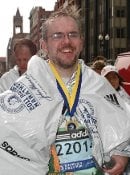Mike Agostini

- BS Mechanical Engineering 1997
- MS Mechanical Engineering 1999
How (and why?) do you run a marathon? by Dennis Walikainen '92 '09 You start with a cause. Or, at least you do if you are Mike Agostini '97, who has run two Boston Marathons: one properly, one not so well. "I started running in Japan in 1993;94 during a study abroad trip," he says. "I did it to curb my hunger, since running is an appetite suppressant, and I was broke. Fast-forward thirteen years. Agostini is living and working in Boston, home of the world's most famous 26.2-mile jaunt. No longer hungry, he found a different inspiration to take up running in a serious way. "Some colleagues [at MathWorks] were running for the Dana-Farber cancer research center, and I wanted to help out," Agostini says. "So, for that first marathon, in 2007, I raised over $8,000 for a couple family members hit with the disease, as well as two close friends. It was my way of striking back." "I also ran for Sierra, the daughter of my advisor, [mechanical engineering professor] Gordon Parker, who was diagnosed that year." (Sierra is doing fine now, four and one-half years cancer free and attending Tech.) He did the requisite six months of training, but he didn't listen to his body, which was trying to give him two important messages: he had an injured knee, and his tendons were damaged, a result of not replacing his worn shoes. His form got worse, and during a training run of twenty-plus miles, he injured himself. "I couldn't train the six weeks before the marathon," Agostini says. "When the day came, I wasn't sure whether I should run or not. I rationalized running anyway, since I'd raised all that money." Big mistake. He needed nine months off after the marathon to fully heal. He wouldn't do that again. In April 2011, Agostini prepared the right way, this time in memory of his father, Mike, who had passed away from cancer. So, what is the right way? "You start with a base of three to four miles a day, three times a week," Agostini says. "On the weekend you focus on running a longer distance. The weekend run starts at four miles and gradually increases over six months." You give yourself breaks, too, from those increases in length, he says. So a training regimen on the successive weekends might encompass eight miles, five miles, ten miles, six miles, etc., working up to that twenty-mile trek. "Nutrition is also important," he says. "You need to keep up the sugars, glycogen, so I take along GU Energy Packs and take one before and one every thirty to forty-five minutes of your long runs." He also adds variety to his workouts, to help both his marathon time and his body's recovery. "Training on hills and speed work [during the week] gives you added strength that goes deep into those longer runs," Agostini says. What difference did the training, nutrition, and new shoes make? Agostini finished his 2011 second marathon in four hours and thirty-five minutes, whacking forty-five minutes off his 2007 time. And instead of enduring nine months of convalescence, he was back on the road training five days after he crossed the finish line. And, most importantly, "I raised $16,000 for cancer research to honor my dad," he says. Excerpted from the article "How (and why) do you run a marathon," by Dennis Walikainen '92 '09, which first appeared in the Fall 2011 issue of Michigan Tech Magazine, Volume 48, Number 4